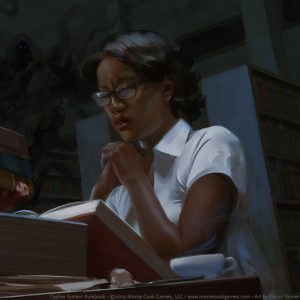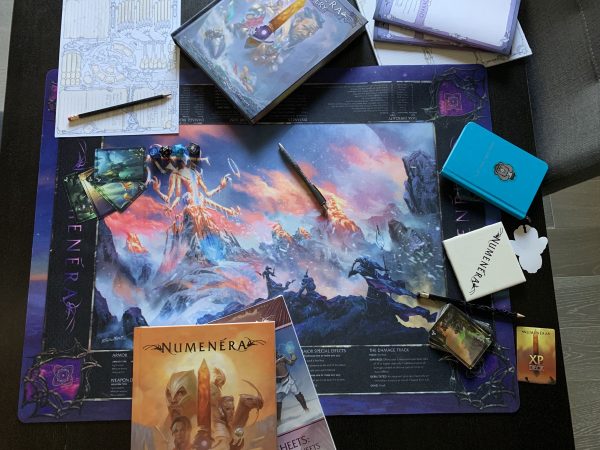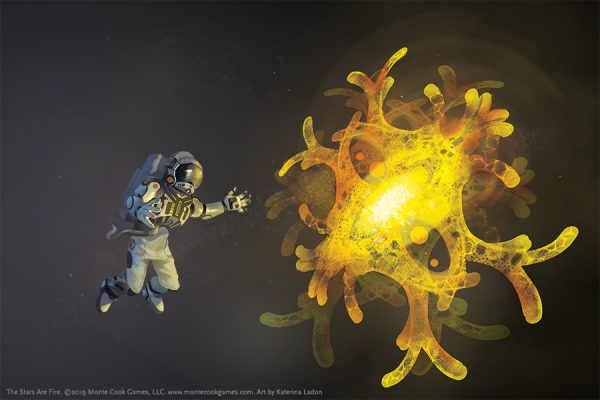What does it take to run a Cypher System game for a single player?
The Cypher System is extremely flexible—I’ve used it for large groups, like a Predation game Troy Pichelman and I ran across two tables and 12 players, all the way down to one player and one GM, as in the Party of One podcast Numenera episode. Because of the way the Cypher System is designed, you won’t break the game by changing the player count.
However, there are some tips and tricks to make a one-on-one game feel dynamic and exciting in lieu of the sweet chaos of additional players. Our designers weigh in with their best advice for running single-player games using the Cypher System!
Monte’s Guide to One-on-One Gaming
Cypher is well suited for one-on-one gaming because, in general, characters are quite self-reliant. Any character can spend effort on any task, and important tasks—like healing injuries—aren’t siloed into a single character type.
 That said, as the GM you need to be pretty aware of who the character is. For example, the difference between the foes that a combat-focused character (like a Glaive or a Warrior) can reasonably take on alone are very different from those that a non-combat-focused character (like a Nano or an Adept) can cope with.
That said, as the GM you need to be pretty aware of who the character is. For example, the difference between the foes that a combat-focused character (like a Glaive or a Warrior) can reasonably take on alone are very different from those that a non-combat-focused character (like a Nano or an Adept) can cope with.
In general, one-on-one gaming is a lot “roomier.” A scene that would take a group an hour to play through might take only a half hour or less with a single player. That means there’s more room to provide detail and depth. NPCs can (and should) be more developed, and probably more nuanced.
Many players will find that it’s actually easier to get into character and stay there without others around. Some will enjoy the constant spotlight, while others will appreciate fewer real-world eyes on them. There’s also just less real-world distraction—fewer out of character comments and jokes. If it’s just you, your mind focuses more on, “What does my character think or feel about this situation? What would it really be like to be there?”
On the flip side, there’s no one else to play off of. No one to rely on. That can make some elements harder. For some, the game might seem emptier and drier, so the GM might have to work harder to keep things interesting. The best way to do that is to really specifically focus on the one character and make it about them at every turn, while also giving the PC leeway to observe and explore more—it’s a very different experience to be the single PC and be the sole voice.
The player should consider asking more questions. For example, if you’re the single player and you don’t look at a person or a thing, it doesn’t get seen. Think of the video footage you would get walking into an interesting place in real life with three or four people each taking their own videos, compared with the footage you’d get if only one person had a camera.
Mechanics: During character creation, you may want to ignore the connection to another PC from your focus. Alternatively, apply the connection to an NPC “buddy,” as Sean recommends, or have the player play two characters, as Shanna discusses below. Further, GM intrusions should award only one XP, not two, as there’s no one else to receive the other XP.

Additional advice and ideas:
- Shanna—Try playing two characters as a single player. One-on-one roleplaying is a great opportunity to take a step back from the typical structure of gaming and take a deep dive into the storytelling aspects. With just one player and one GM, there’s a lot of collaboration potential, where you can work together to create interesting story moments and character arcs. Last time we played, I played two characters, which the GM and I had built together, so we both had a strong sense of who these characters were and the kinds of stories that would pull out their potential. Playing two characters also allowed me, as the player, to create interactions and small tensions between the two, or to have them work together as a team to overcome difficult obstacles.
- Sean—Give the PC an NPC buddy. Many times, the PC needs a second pair of hands, and having it be an NPC means the player isn’t having to play two characters. Plus, if the PC is knocked unconscious or captured, the NPC is able to rescue them or carry them to safety (the GM could have the player take over the NPC for a bit until the PC is in control again). And because Cypher System NPCs are very streamlined in terms of how they interact with the rules, it’s easy for the GM to pit the NPC against a challenge (a combat opponent, skill task, etc.) and immediately know based on the compared levels if the NPC is going to succeed, fail, or buy some time for the PC to save the day.
- Bruce—Give NPCs a little extra flair. Lots of players mean lots of personalities. One player means it’s just them and the GM. The GM should take a bit more time before the game jotting down one memorable tic/look/personality trait and one clear motivation for the various NPCs the PC might run into, just to add a bit of variety and color to the game. That’ll not only be interesting to the player, it’ll also make the game more fun for the GM.
- Sean—Let the cyphers flow. Make sure the character has a lot of opportunities to get new cyphers. With no other PCs in the group, there are fewer cyphers in play during the session. If the character can acquire replacement cyphers more frequently, they’re more likely to use the cyphers they have.
Have you tried playing a one-on-one Cypher System game? We’d love to hear about your experience—use the hashtag #CypherSystem to participate in the conversation on social media.
